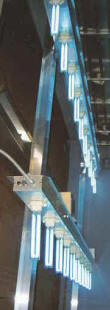|
|
|
|||||
|
Advanced search
|
UVC Light Beats Heat and Saves Energy in Dallas
In 1998, with 56 days of temperatures 100 F or more, it's not surprising that utility bills in Dallas ran 15 to 35 percent higher than typical summers. Again, during the summer of 1999, record breaking heat forced building operators to crank up their air conditioning systems-sometimes for 24 hours a day. But at the headquarters of Central & South West Corp. (CSW) both this year and last, building services technician David Lewis reports a significant decrease in energy usage. Through the brutal 1998 summer, he says, they were able to cool the near 500,000-sq. ft. building coasting along on a maximum of three, 300-ton chillers instead of the customary four. That amounts to an estimated 300+ kW reduction when factoring in the related equipment.
How did CSW manage to defy the statistics and save on chiller demand during record-breaking heat (Dallas's second hottest summer ever)? Lewis attributes the reduced demand to the February 1998 installation of UVC germicidal lights
Lewis installed the UVC Emitters in all 20 of the building's air handling units, which ultimately made further use of the increased cooling efficiency with their "variable frequency drive" fan motors. "When we purchased the product, we weren't even looking for energy savings: our motivation was indoor air quality (IAQ)," stated Lewis. "Though we didn't have a specific IAQ problem in the building, we always try to be environmentally proactive."
CSW is a global, diversified company whose holdings include America's second largest utility system. The company owns many electrical operating subsidiaries in Texas, Oklahoma, Ohio, Missouri, Louisiana, and Arkansas. In fact, it was through one of these subsidiaries -Public Service Company of Oklahoma (PSO) in Tulsa, Okla.- that Lewis first became convinced of the benefits of UVC light. PSO had installed the lights in 1996 and 1997 to eliminate a persistent mold and IAQ problem in the majority of their HVAC systems. They found that, by bathing the coil and drain pan areas from the downstream side with a newly developed UVC product, they were able to eradicate the microbial growth and its related problems. The lights also all but eliminated most of their customary coil cleaning maintenance.
"In following the PSO example, we too have eliminated our four-times-per-year coil, drain pan and plenum cleaning program and we no longer expose our maintenance people to the biocidal agents and other cleaning chemicals required for these tasks. The environmental benefit is a very big plus for CSW, not to mention a big cost saver," said Lewis. "What we didn't anticipate was the rather significant improvement in coil heat transfer efficiency, pressure drop and the subsequent lower fan rpm. This all results from having our coils continuously clean by the UVC lights. It also translates into a big power consumption reduction." (continued at top of next column) |
"So when the energy savings are added to the maintenance savings and IAQ proactivity, they are all proving significant. What's more, we are happy to see similar savings this year," said Lewis. "Those who utilize variable frequency drives (VFDs) on their fans, etc., will quickly see the promised energy savings once the lights have cleaned their coils. Those considering VFDs may have more incentive now to use them. Constant speed fan users will at least need to check their damper settings, but many will be able to shave back to the original design rpm for substantial energy savings."
Lewis also noted that coils have remained free of mold and organic buildup for nearly a year and a half with any chemical cleaning or biocidal treatment. "We regularly test samples taken from coil surfaces as well as our condensate water, and these samples repeatedly come back clean, so we're confident that the lights are performing the desired germicidal function too." CSW maintenance crews installed a total of 170 UVC light fixtures in the building's air handlers. A radiometer is used at each air handler to measure the UVC output of the lights. When that outputs falls below the specified level, the bulbs or "Emitter tubes" will simply be replaced. "We're told that an annual changeout cycle is typical, but we are just now changing them after almost 17 months of bulb life," Lewis reported. He also expects that the UVC device will prolong the useful life of the building's older air handler through cleaner, more efficient operation. "Coil replacement looks like it's still a long way off, if ever." Half of the facility is 27 years old and still equipped with the original air handling units. They were retrofitted with VFDs in the late 1980s. The newer half of the building was constructed about seven years ago with VFDs installed.
With the PSO subsidiary coming up on four years' experience with the UVC lights, facility supervisor Tom McKain also reported significant maintenance and energy benefits.
"These lights have the ability to restore a marginally-performing air handler to peak efficiency-bringing it back, essentially, to "as new" condition," said McKain. "Once our coils were free of residue, we were able to rebalance all of our air handling units and reduce fan speed to a lower rpm. Due to this increase in efficiency, we estimate that the lights paid for themselves in about six months of less-much faster than we'd anticipated. And we haven't had to clean our coils, drain pans and plenums since 1996."
Tulsa, like Dallas, experienced record-breaking heat last summer, yet the PSO facility-like its parent company in Dallas-was able to reduce chiller demand also, cutting back from two chillers to one. "The UVC lights have performed beyond our expectations in all regards," McKain concluded.
From Electric Light & Power, February 2000
|
||||
| Last modified: 02/05/2016 01:40 PM | ||||||


